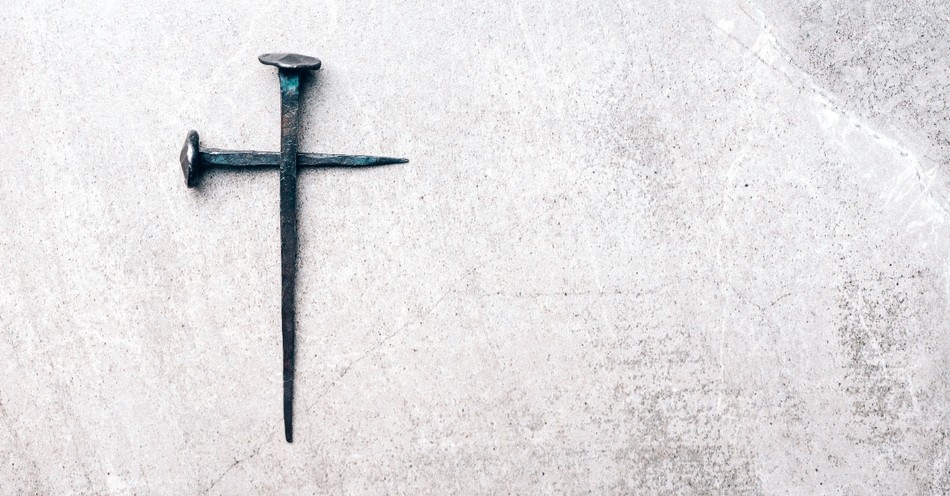The world is filled with the image of a man nailed to a cross: one man, Jesus.
Catholic churches place statues and paintings around the worship area of Jesus nailed to the wooden beams of a cross. Crucifixes are hung in people’s houses and around their necks as reminders of his sacrifice. The form of Jesus on the cross is on T-Shirts, television shows, movies, and other media. The crucifix is both a disturbing and inspiring image – disturbing in the violence and reality of our own sin; inspiring in the gift that our corruption was annihilated by the death and sacrifice of the Son of God.
In the Western culture and the world in general, we seem far away from that brutal and barbaric act, of hammering nails through the flesh of a man to execute him as a criminal. Still, we are curious about the process, the materials used like wood and metal. Specifically, what about Jesus’ nails? Those nails fastened Christ to that public, gruesome display. As we know, it wasn’t the nails that held him there, but his love for us and obedience to his Father (John 10:18). Jesus’ nails, however, have ancient legends attached to them and even recent archaeological discoveries.
Why Were People Nailed to Crosses?
Rome began as a colony of Greece, ultimately breaking away, taking the military technology from Greece and improving upon it to start conquering Northern Africa and Western Asia. Rome became the largest, most powerful empire up to the time Jesus was born. As a conquering force, on the one hand, Rome brought better roads and the peace we now call the Pax Romana, a stable era in the area that many scholars surmise contributed to the spread of Christianity.
At the same time, people must be oppressed and controlled to be conquered. Slavery was rampant in the Roman Empire 2,000 years ago. Crucifixion may be a thing of the past, but control over others always takes lies, fear, and violence. Rome was famous for adopting and improving upon the ideas and methods before them, and nailing people to crosses was no different.
Public executions have a long history, from beheadings and hangings to impalement. A central element of those executions would be to humiliate the criminal as an example to the other individuals in attendance, often continuing to display the remains as a deterrent.
The first mention of crucifixion is from the Assyrians around 600 BC. Assyrians, known for their capital, Nineveh, were a brutal and cruel nation and noted for their sadistic practices to intimidate cities and regions. God used the people of Assyria to destroy the northern kingdom of Israel finally, and Hezekiah had to deal with the Assyrian invasion, needing God’s help to defeat them (2 Chronicles 32).
Crucifixion was used widely throughout the Persian Empire by 400 BC, the powerful nation after Assyria and Babylon. Biblical figures like Mordecai and Esther lived under the Persian kings. An important element in Esther’s story is how Haman built a pole to impale Mordecai but was eventually executed by that same pike. Impalement is a close cousin to crucifixion.
The Romans used crucifixion all over the Empire for those convicted of a serious offense. It was rare for legal citizens to be nailed to a cross, and women never were. Crucifixion was extremely painful, and it took days for the man to die, generally by suffocation.
When Jesus spoke of carrying the cross (Luke 9:23), the Jews understood they were second-class citizens or slaves, comprehended the immense anguish involved, and could probably see men writhing in the throes of death along the road while they traveled.
What Kind of Nails Were Used and How Big Were They?
The upright post was usually a permanent fixture. The convicted criminal would have carried the horizontal crossbar through the city as part of the humiliation. It wasn’t uncommon for the man to have been beaten severely before carrying that wooden beam on his shoulders, as Jesus had been. Jesus of Nazareth bore that cross all the way to called Golgotha, the Hill of the Skull, an area of higher elevation to make the execution more visible.
The Roman Centurions and guards would have laid Jesus upon the ground and started hammering nails through his body. Those nails were seven to nine inches long and fashioned of heavy iron, not rounded but with square edges along the shaft of the spike. The Centurion would have first driven the nails through small wooden discs to help hold the nails in place. Then the Roman guards pounded a nail through one side, followed by the other.
Once bound and nailed to the cross, Jesus would have been lifted to the upright post. Christ’s shoulders were pulled out of joint, and to breathe, he needed to push up on his legs to get air in his lungs, which required continual effort and caused severe pain. The man on the cross would do this for hours, perhaps days, until he became so exhausted and weak that he would suffocate. The Romans would break the legs to hurry the process, effectively strangling the man to death. Scripture mentions the Jewish leaders wanted the crucifixion to end before the Sabbath, so the Romans went to break Jesus’ legs but discovered Jesus had already died (John 19:31-37).
Was Jesus Nailed in the Palms or the Wrists?
The nails on either side of the cross needed to be strong enough to hold up a man’s body. Despite much of the Christian imagery and literature over the years, Jesus was not nailed through the palms. The meat of the palm wasn’t strong enough to bear the weight; the nail would have ripped right through the hand. Instead, the nails went through the wrist.
The Centurion had to be an expert. It took extreme precision since the incision point must be perfect: between the bones near the wrist but without severing arteries (which would kill the man from blood loss). Bleeding to death would have been too fast for the Romans, who desired a long and excruciating execution.
Regarding the feet, it is likely the right foot was crossed over the left, and the feet were nailed together to the upright post.
Do We Still Have the Nails Used to Crucify Jesus?
Over the last couple thousand years, 30 or more nails have been claimed as “holy nails” from the crucifixion and Christian relics.
Centuries after the death of Jesus, the Roman Emperor Constantine sent his mother, Helena, on a mission to find the cross and nails of Jesus. Helena searched and found the cross and nails, at least according to the story. Miracles were said to have authenticated those items. The wood of the cross was placed within a cathedral. One of the nails Helena found was used to make a bridle for Constantine’s horse, and the other as part of his helmet.
More recently, in the 1970s, archaeologists found a cave many believe to be the burial place of Caiaphas, the Jewish High Priest that condemned Jesus and sent him to the Romans to die. Two nails were discovered in the tomb, and many thought those could be the nails used to kill Jesus. The nails went missing soon after.
Those nails were reportedly found again around 2010, some Christians once more asserting that they were used to crucify Jesus. While we can’t know whether they are the same nails as Jesus, study has found fragments of bone and wood in the iron of the nails, making us confident that they were used in the crucifixion of an anonymous individual.
We may never know whether we have the nails or the wood used in the crucifixion of Jesus. However, through faith and the word of God, we know that God’s heart was so filled with abundant, extravagant love for us that he gave us the best he had to give, his only Son, to die as a perfect sacrifice so that we can be raised with Christ as sons and daughters of the Father.
Peace.
Photo Credit: © Getty Images/jchizhe

Learn more about the meaning and significance behind the Easter holiday and Holy Week celebrations:
What is Lent? and When Does Lent Start?
What is Ash Wednesday? and When is Ash Wednesday?
What is Palm Sunday?
What is Maundy Thursday?
What is Good Friday? and When is Good Friday?
What is Holy Saturday?
What is Easter? and When is Easter Sunday?
Easter Bible Verses
The Resurrection of Jesus
Easter Prayers



_639003522088907085.jpg)